Your Planets
Portraits of the Planets
Aspects between Planets
The planetary ages
The planetary families
Planets in Signs
The Planets in comics


Like the Signs of the zodiac, aspects are characteristic phases of a cycle (aspects of a planet at its native position) or intercycle (aspects between two stars). One aspect is the angular distance that separates or connects the positions of two celestial bodies with respect to the center of the Earth. Astrologically, an aspect establishes a privileged relationship, consonant or dissonant, between two or more of the “psychological poles” that the different planets represent.
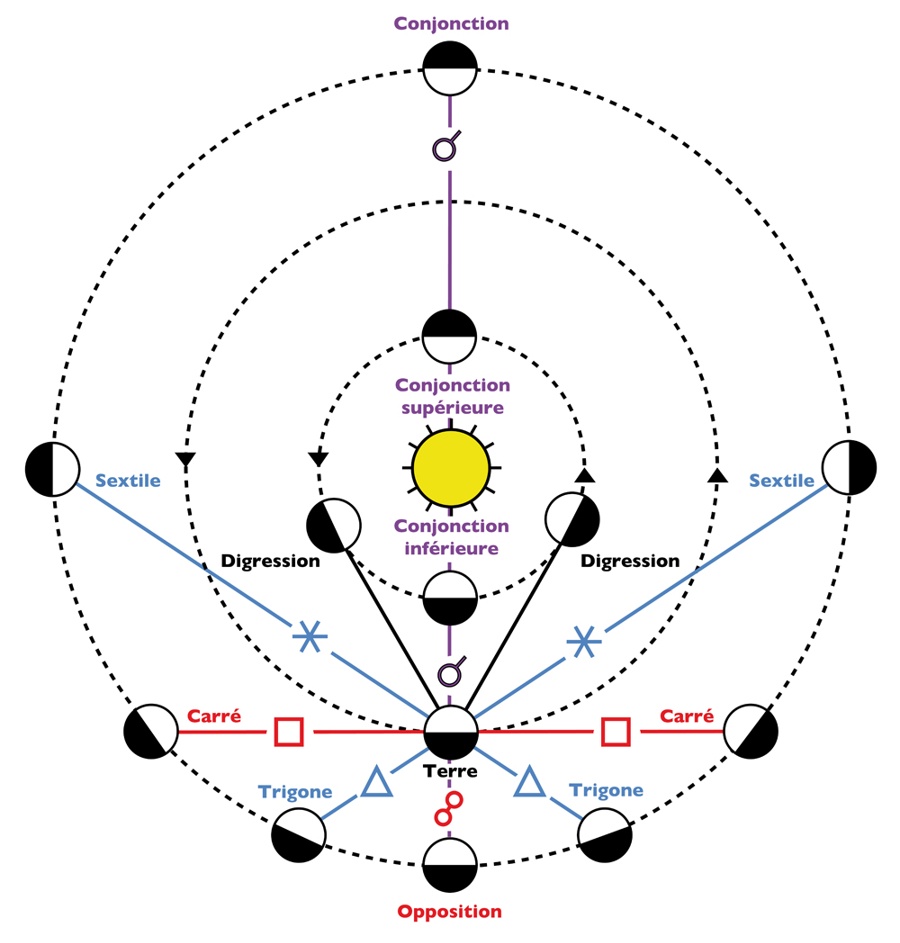 Like the Signs of the zodiac, aspects are characteristic phases of a cycle (aspects of a planet at its native position) or intercycle (aspects between two stars). One aspect is the angular distance that separates or connects the positions of two celestial bodies with respect to the center of the Earth. Geometrically, an aspect can be represented in the form of a triangle whose vertex would be the center of the Earth, and the base the straight line which passes through the center of the two planets in question. An aspect is therefore a geocentric and heliocentric astronomical reality (it measures the intercycle specific to two or more planets).
Like the Signs of the zodiac, aspects are characteristic phases of a cycle (aspects of a planet at its native position) or intercycle (aspects between two stars). One aspect is the angular distance that separates or connects the positions of two celestial bodies with respect to the center of the Earth. Geometrically, an aspect can be represented in the form of a triangle whose vertex would be the center of the Earth, and the base the straight line which passes through the center of the two planets in question. An aspect is therefore a geocentric and heliocentric astronomical reality (it measures the intercycle specific to two or more planets).
Ecliptic longitudes & latitudes
Traditionally, aspects are calculated from the positions in ecliptic longitudes of the planets they connect: their ecliptic latitudes, that is, their Heights positive or negative with respect to the ecliptic plane, are therefore not taken into account. These calculations based on the ecliptic longitudes are explained by the fact that these reflect the fact that the aspects are not angles frozen in space, but characteristic phases of the temporal intercycle between two or more planets. Thus, a planet located at ± 180° from another in ecliptic longitude is in opposition aspect, that is to say at half the intercycle between these two planets, regardless of the latitudes. eclipses of these. Similarly, a planet located at ± 0° from another in ecliptic longitude is in conjunction aspect, that is to say at the beginning of the intercycle between these two planets, even if one of them they are much higher or lower than the other on the ecliptic.
To understand this phenomenon, let us take the example of the Moon-Pluto conjunction in the Natal Chart of Carl Gustav Jung. It is located in the Sign of Taurus, in House III, Pluto being angular at the Imum Coeli.
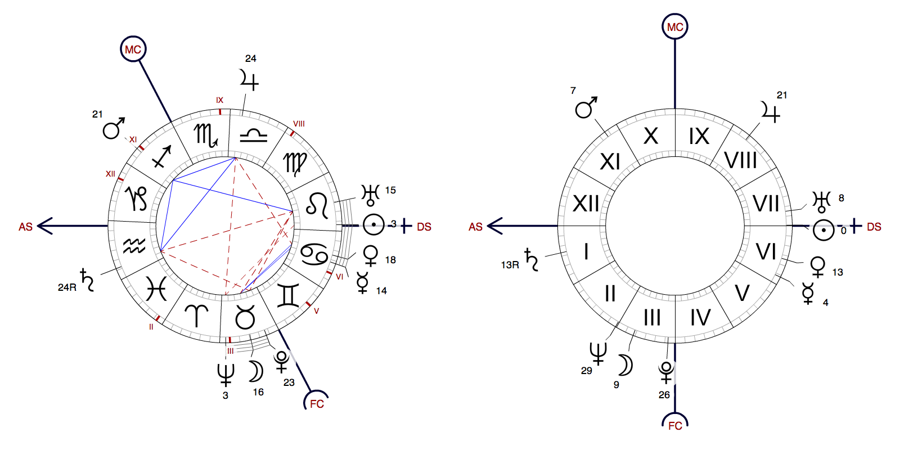
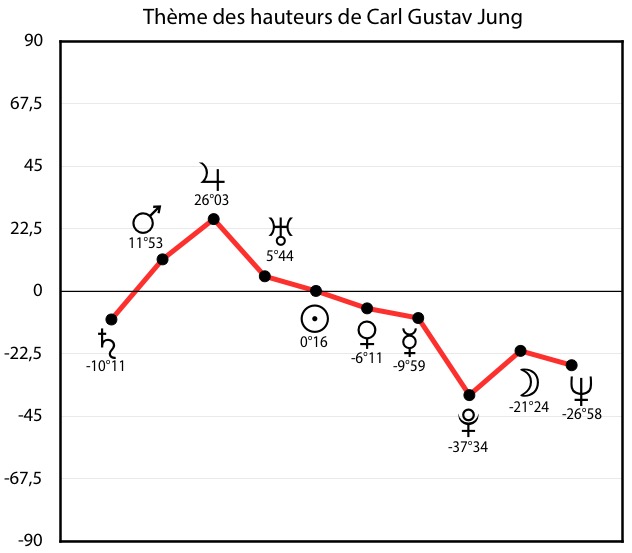 The ecliptic longitudes are 15° 32′ for the Moon and 23° 25′ for Pluto. They are therefore conjoined in an orb of 7° 52′. Their ecliptic latitudes are +2° 53′ for the Moon and −14° 19′ for Pluto, which means Pluto is 17° 02′ lower than the Moon.
The ecliptic longitudes are 15° 32′ for the Moon and 23° 25′ for Pluto. They are therefore conjoined in an orb of 7° 52′. Their ecliptic latitudes are +2° 53′ for the Moon and −14° 19′ for Pluto, which means Pluto is 17° 02′ lower than the Moon.
▶ The figure opposite, which represents Jung’s Height Chart, allows you to visualize this phenomenon: we can indeed observe that Pluto has a negative height (below the horizon) much higher than that of the Moon.
▶ If we take into account this differential in ecliptic latitude between these two planets, their conjunction in ecliptic longitude is considered non-existent… even though they are still in the beginning phase of their intercycle, in an orb of 7° 52′ which is not excessive.
▶ It follows that it is indeed the ecliptic longitudes which must be taken into account for the calculation of the aspects, their ecliptic latitudes apparently playing only a minor role here… the probable effects of which nevertheless remain to be explored.
Astrologically, an aspect establishes a privileged relationship, consonant or dissonant, between two or more of the “psychological poles” that the different planets represent.
The aspects being in some way transmission links between several planetary functions, astrology has looked with profit at the solutions adopted by the nervous system to make the neurons (nerve cells) communicate with each other.
Simplifying, neurons can be divided into two groups: the “agonists” and the “antagonists”. The relationships between synergistic neurons or groups of neurons strangely resemble the observed effects of consonant aspects, and those between antagonistic neurons to the effects of dissonant aspects.
Not all angular distances between planets are significant, and among those that are, not all have the same relative power: there is a hierarchy of aspects.
Astrological tradition and experience have demonstrated the predominance of the so-called “major” (in order: conjunction, opposition, square, trine, sextile) on the said aspects “minors” (semi-square, semi-sextile, quintile, sesqui-square, etc.). The influence of the latter can be considered as weak or very weak: it is in any case negligible, compared to the effectiveness of the major aspects.
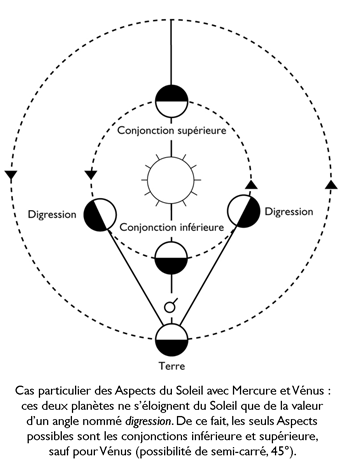 Aspect Theory
Aspect TheoryAspects can also be divided into two other categories: consonants and dissonants. By retaining only the major aspects, the consonant aspects (trine, sextile) are known to induce a harmonious, relaxed relationship between the planets they connect. The dissonant aspects (opposition, square), go on the contrary to create tensions and conflicts. As for the conjunction, its particular nature makes it participate in both groups at the same time.
To theoretically justify the number and quality of aspects, astrology has long been based on simple geometric figures that can be inscribed in a circle (triangle, i.e. 3 times 120°, cane, i.e. 4 times 90°, various polygons). More pertinent observation and further research have challenged this notion of a circle: indeed, the relationships between the planets are actually the harmonics of their dynamic cycles and intercycles, and not the static circle by which we represent them: by For example, a Sun-Mars opposition indicates that these two planets are halfway through the duration of their intercycle (360°/2 = 180°).
In fact, a simple mathematical law justifies the predominance of the major aspects: they are indeed part of the same geometric progression, that of the powers of 2 for the dissonant aspects and those of the arithmetic means of the powers of 2 for the consonant aspects. Two minor aspects, the semi-square and the semi-sextile, come under this same law: as such, their importance should not be overlooked, without overvaluing it.
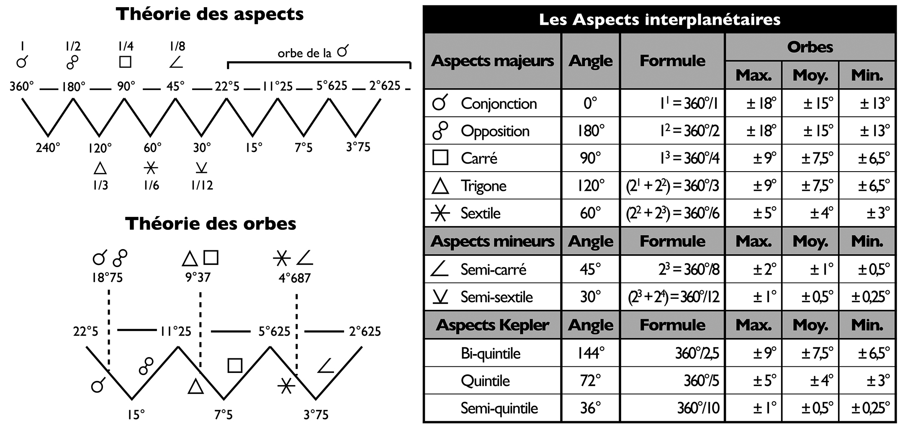
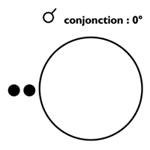
Two planets are said to be in conjunction when the angular distance between them is 0° (or 360°, which is the same). The conjunction formula is therefore as follows: 360°/1 (or 0°/1) = 360° (or 0°) The conjunction is therefore determined by the divisor 1 (unity, synergy), but also by the whole sequence possible divisors beyond 24, if we take into account the orb inside which we admit that a conjunction exists (18° maximum on either side of the exact aspect for fast planets and angular, 14° for aspects between slow planets, 16° for aspects between fast and slow). It therefore contains virtually all the minor harmonics of the consonant or dissonant aspects. In this sense, the conjunction is the place of all the potentialities of the planetary intercycle that it induces. It is easy to realize this (see figure above) by continuing the momentum of the geometric progression:
▶ Consonant: 360°/ 24 = 15°
▶ Dissonant: 360°/ 32 = 11.25°
▶ Consonant: 360°/ 48 = 7.50°
▶ Dissonant: 360°/ 64 = 5.625°
▶ Consonant: 360°/ 96 = 3.75°
▶ Dissonant: 360°/ 128 = 2.8125°
▶ Consonant: 360°/ 192 = 1.875°
▶ Dissonant: 360°/ 256 = 1.40625°
From divisor 64, we enter the field of what astrologers call a close, hyper-precise conjunction. It includes by mixing them until the indifferentiation the consonances and the dissonances. However, an aspect does not need to be exact to be effective, and, in practice, it is impossible to observe the difference between a conjunction at 1.40° and another at 1.87°…
The nature of the conjunction can therefore be consonant (relaxed, unifying the forces it connects) as well as dissonant (tense, conflicting). We will judge its effects according to the nature of the planets in conjunction, according to the aspects that it receives itself, and of course according to the answer that the living individual will have given to the question posed to him by the conjunction, taking into account his background, his experience, his education. Analogously, we can liken the conjunction to an egg, carrying all possibilities.
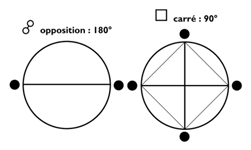 These are the major dissonant aspects. Their formulas are as follows:
These are the major dissonant aspects. Their formulas are as follows:
▶ opposition: 2 to the power of 1 (divisor 2) = 360°/2 = 180°
▶ square 22 (divider 4) = 360°/4 = 90°
The semi-square, minor aspect, comes from the same progression:
▶ semi-square: 23 (divisor 8) = 360°/8 = 45°.
These aspects are called “dissonant” because, being determined by the ratio 1/2, they express a division, a discontinuity. The psychological tendencies expressed by the planets connected by dissonant aspects clash, each seeking to take precedence over the other. Obviously, badly integrated, badly managed or badly experienced dissonances can induce deep tensions and painful contradictions within the psychic universe. However, the experience and practice of astrology show that beings who manage to dynamically manage their conflicts and contradictions — and therefore their dissonances — become more vigilant, more masters of themselves, more solid than others… squares and oppositions don’t only have bad sides!
The problems posed by the conflicting dynamics of dissonances can lead to multiple individual responses or behavioral scenarios. The most frequent answers range from the flexible or rigid subordination of one tendency to another, to the partial or total repression of one tendency by another:
Flexible, alternative subordination
This is frequently the case when the planets in aspect have substantially the same relative power. Neither of the two planetary functions agrees to yield to the other, which generates conflicting or discordant behaviors. At worst, the individual, traumatized by his contradictions, no longer knows on which foot to dance or, when he dances, does it at the wrong time: the wrong step at the wrong time.
At best (that is to say after many difficult experiences thanks to which the individual can end up becoming aware of the suffering and dysfunctions that his poorly managed contradictions have caused him), a more or less flexible alternation is possible. We then learn to dance in rhythm, to compensate for one trend with another. Between the worst and the best spreads the vast color chart of possible responses to a square or an opposition: waltzes-hesitations, sudden and disharmonious compensations.
Example:
Take the case of a dissonance between Mars and Saturn. Schematically, such an aspect opposes action to reflection, immediate presence to distant distance, raw experience to the questions it arouses: it is a priori difficult, for a being born under a square or a Mars- dominant Satumes, to harmoniously coordinate these two modes of reaction to reality.
At worst, he will be reluctant to act (Mars) for fear of the complex consequences of his actions (Saturn), while hesitating to think too much for fear of being unable to act. Nevertheless, he must respond well to the situations with which he is confronted and therefore make choices: thus, anguished by the perplexities that his questions cause him (Saturn), he will feel obliged to act impulsively (Mars) to ward off this anguish… and will thus pay the disastrous dividends of its excess of anti-thoughtful activism: one rushes on, without worrying about the long-term consequences of one’s actions, even if it means going recklessly to face the worst difficulties.
Conversely, the same aspect can cause a being, endowed with a powerful need to act (Mars), to fear “do wrong” by lack of reflection (Saturn): we always put off until later (“after careful consideration”) the concrete decisions that are necessary.
Mars and Saturn participate in the level “Existence” in the R.E.T. system They have in common their lack of ‘R’, from “Representation”. In the case of a badly experienced dissonance, this lack of “Representation” (“non-R”) will be very noticeable: difficulty in seeing clearly in one’s experience, in setting mobilizing objectives, in drawing immediate benefits from what one does. At worst, we never live gratifying experiences, we never manage to be recognized socially. We get bogged down in the swamp of concrete difficulties. We complicate our lives. We are unable to find simple solutions to the problems of existence.
At best, a well-lived and well-integrated Mars-Satume square or opposition lets you know that there is a time for action and another for reflection. In this case, when the time to act (Mars) comes, no doubt, no questioning comes to paralyze the impetuous movement which pushes to vigorously confront reality. Either because the action has been carefully thought out beforehand, or because we have understood that there are situations that absolutely require visceral, primary, instinctive responses.
Conversely, we also know how to silence and control our desires to act when, obviously, the time is more for reflection and meditation (Saturn): we know how to disinvest in the present situation in a timely manner, save our forces for future battles… to be more effective when the situation does call for vigorous reactions.
This time, the “non-R” of Mars-Satum no longer poses insurmountable problems, it can even become a strength: we do what we have to do and think what we think, making fun of it a lot of the opinion of others. We work in the shadows, discreetly, without expecting any public recognition whatsoever. We do not want to be an example, a model, a reference. We are ourselves, center in our actions (Mars) and populated by our uncertainties (Saturn), and we feel that we do not have to explain or justify ourselves (“non-R”). And we cast a caustic, even contemptuous gaze on those who want at all costs to occupy the front of the stage, to have the good part, the good talkers, the socialites, the exhibitionists whom we judge without thickness or depth.
Between the worst and the best of this Mars-Satum dissonance that we have taken as an example, there is the vast spectrum of possible responses to this aspect: we blame ourselves for being so hesitant and thoughtful (Saturn) when we would so much like to live hand-to-hand with the world (Mars), we can’t stand being so activist (Mars) when we say to ourselves, deep down, that we should be more philosophical (Saturn). We get lost in battles (Mars) and we get lost in the wise distance (Saturn). We blame ourselves for its cautious retreats (Saturn) by being exalted by its reckless face-to-face encounters (Mars). We pride ourselves on its ability to stay above the fray (Saturn) while being unable to resist rushing into it with passion (Mars).
Rigid, systematic subordination
This phenomenon occurs, either when a planet is clearly more powerful than another (for example, a square or an opposition between a ruling planet and another non-dominant), or when the planets in aspect are of substantially equal strength, and the objective constraints of education, learning and the environment in which the subject is located encourage the individual to adopt this type of response to the dissonances of its chart.
In this case, at worst, there is total repression: the psychological tendencies expressed by one of the planets involved in the dissonance are simply not allowed to express themselves. This repression can possibly take the form of sublimation: the individual then makes the “sacrifice” of a part of himself that he considers, rightly or wrongly, not to be able to integrate. At best, there is a mechanism of fruitful mastery of one tendency by another. Between the worst and the best and in this case, it is not difficult to imagine the various manifestations of the revenge of the repressed: the tendencies of himself that the individual thought he had definitively mastered, eliminated, padlocked to the name of a “psychic normality” which allowed him to maintain a precarious and deceptive balance, suddenly resurface.
Example:
Let’s keep the same example: a Mars-Satume dissonance. At worst, there is repression of Mars by Saturn, or repression of Saturn by Mars. If Saturn drives back Mars, the individual raises against the necessities of action (Mars) the thick ramparts of a disillusioned reflection or a pessimistic philosophy (Saturn) which incites him to think that basically, nothing is worth worth nothing. This very cerebral and perhaps very seductive doctrine of renunciation, however sophisticated it may be, will nonetheless be the screen justifying a shameful inability to act, a fearful and anguished refusal of confrontation in the name of the delights introspection or theory.
If Saturn pushes back Mars, we are so afraid of doing that we theorize a priori on all the good reasons there are for doing nothing… conversely, if Mars pushes back Saturn, the individual is strictly incapable of anything. return on oneself, of any step back whatsoever vis-à-vis his thoughtless and disheveled activism. He lives “at close range”, without distance or perspective. Direct action, permanent brutal confrontation are for him a viaticum against doubt, reflection, meditation or melancholy. We are here in the presence of a boor, anti-speculative, anti-intellectual, totally indifferent to the distant consequences of his thoughtless acts.
At best, Saturn controls (nothing to do with the Planetary rulerships) perfectly Mars, or Mars perfectly masters Saturn. In the first case, the reflective thinker or the unrepentant romantic (Saturn) knows that direct action (Mars) is necessary and inevitable… but that reason and perspective must be kept in all circumstances. Action is no longer anything more than a tool for deep reflection. Far from looking for direct confrontations, we theorize and set up shadow fights. We resign ourselves to heavy realism when there is no way to do otherwise, without being overwhelmed: thought always governs. Eventually, we pull the strings of conflict, without exposing ourselves to the front line: what’s the point, when we master duels?
In the second case, if Mars masters Saturn, the warrior or the realist of the immediate (Mars) knows that distance, skepticism and reflection are essential… certainly, but that in no case should they become obstacles to pure action, the appetite for living here and now. All things considered, reflection serves no other purpose than to intellectually buttress the ultimate truth of raw existence. The man of action, far from being helpless in the face of the philosopher or the idealist, reminds him that above all, it is a fight for (sur)life that is at stake. We keep our doubts, questions and reservations in a lucid but discreet way, which does not prevent us from fighting: the warrior is a philosopher at times… at times that he decides.
Between the worst and the best, various chaotic scenarios can take place. It is easy to understand, within the framework of rigidity and systematization, that the intermediate solutions between these two extremes will also be extreme: the austere thinker, the fearful shy or the apparently out-of-this-world romantic (Saturn) are suddenly transformed, in an incredible “acting out”, into a violent, ferocious and belligerent activist (Mars repressed), so true that by repressing natural aggressiveness too much, it ends up taking on monumental proportions when it frees itself. We then brutally take our revenge on years of inhibition of action.
Conversely, the brainless activist (Mars) is suddenly metamorphosed into an intransigent cerebral, systematic enemy of any excess that is too primary and primitive. Like Saint Paul on the road to Damascus, he then makes an unjust and implacable trial of all that he was excessively, and then advocates the deep uselessness and vanity of activism, of raw experience, of struggle, with the same blindness that he showed before: he is in great danger of transforming himself into an unrepentant apostle of a desiccated wisdom, a declared enemy of the dualities of existence.
No doubt you have realized, through these few theoretical benchmarks and this unique example (Mars-Saturn), to what extent the responses that man can bring to the dissonant aspects of his chart can be varied… and provisional: in the chronology of learning and experiences, depending on the environment in which one lives and the type of education to which one has been subjected, one can go from “flexible, alternative” to “rigid, systematic”, and vice versa. Nevertheless, with age the answers tend to become more systematic. The older we get, the more difficult it is to change the answers we find to the questions that heaven asks us.
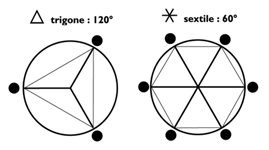 These are the major consonant aspects. Their formulas are as follows:
These are the major consonant aspects. Their formulas are as follows:
▶ trine: (21 + 22) /2 = 3 360°/3 = 120°
▶ sextile: (22 + 23) /2 = 6 360°/6 = 60°
It is therefore the arithmetic means of the powers of 2 that found them. The consonant aspects, not determined by the ratio 1/2, thus express a continuity, a non-division. The planets thus connected function in concert, in complementarity. There is no conflict, no search for subordination, but synergy, collaboration. This sort of “Nonviolence” in the exchanges between the psychological poles represented by the planets implies fluid, relaxed, soothing behaviors.
Example:
It’s always the same: the relationship between Mars and Saturn. If they are linked together by a trine or a sextile, there will be symbiosis between action and reflection: the man in the field is at the same time a thinker. Direct action goes hand in hand with meditation. The intensely felt experience is decanted and deepens as the experiences with which one is confronted. The hindsight and distance that we demonstrate in all circumstances do not prevent us from investing completely in what we do. This is philosophy in action. While immediately confronting the concrete realities, in the urgency of the moment, we wonder at the same time about the merits and the long-term, unknown consequences of his present activity. It is all the more solid, efficient, durable. We pass with ease from the concrete to the abstract, we decant our experiences as we do them.
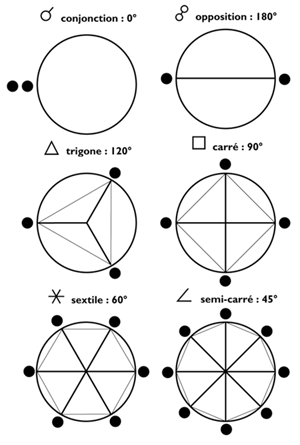 You got it: consonant aspects are easier to live with than dissonant aspects. It is probably for this reason that many astrologers call the first “benefic” and the seconds of “malefic”… In fact, the reality is more complex than that.
You got it: consonant aspects are easier to live with than dissonant aspects. It is probably for this reason that many astrologers call the first “benefic” and the seconds of “malefic”… In fact, the reality is more complex than that.
“Hexes” and “profits” dissonances
A dissonant aspect is indeed a factor of tension. Negatively, this phenomenon of tension can lead to the paralysis of behavior or to permanent conflict: one feels pulled to hue and dia by contradictory impulses, there is a permanent risk of reacting against the current or in an inadequate manner, one accumulates dissatisfaction, frustration, repression. The present planetary tendencies tend to dialectize, to assert themselves against each other in a relationship of mutual reaction or exclusion.
On the other hand, positively, a dissonant aspect can generate lucidity, vigilance; it invites to surpass oneself, to transformation, to mastering one’s tendencies. And it is precisely the transits by conjunction, opposition or square — therefore essentially the dissonant transits — that mark the high points of life, those where we question ourselves through trials that forge character and sharpen the will.
Faced with a natal chart where dissonant aspects dominate, the astrologer cannot know if the individual to which it belongs lives “good” or “evil” the tensions that inevitably involve squares and oppositions. All he knows is that the chart poses a certain type of problem, to which the individual will have to find, as far as possible, appropriate answers. We gain by thinking that at the beginning, the dissonances will not fail to make their “curses”: the personality seeks and builds itself gropingly, gradually becoming aware, as it experiences, of its shortcomings, weaknesses and frustrations. It is only after these difficult experiences that the individual will manage to control his conflicting tendencies, to manage them dynamically, to transform trying tensions into fertile tensions. Then, and only then, the dissonances will have become “benefic”.
“Benefits” and “curses” consonances
A consonant aspect, as we have seen, is a factor of relaxation. Positively, this means: ease, ease, security. As long as the planets connected by a sextile or a trine are in themselves synergistic and complementary, “everything’s fine”: we gently develop our tendencies, sheltered from any lack, from any tension, from any frustration. That’s all “profit” for the individual. However, the consonant aspects also have their “curses”: non-subordination can give birth to a sweet anarchy of behavior. The ease and ease of exchanges lower vigilance. We believe we are naturally immune to difficulties, immune to lack and conflict. There is enough to dull the will and the power to react vigorously to difficult situations.
Moreover, a consonant aspect “shut in” the planets thus connected in the logic of their specific relationship, to the detriment of the rest of the tendencies. For example, with a dominant Mars-Saturn trine, I can be so perfectly comfortable in my role as “active thinker” or of the “meditative realistic” that I will completely forget to cultivate other tendencies of myself. We have seen, these two planets falling under the level “Existence”, have in common their lack of level “Representation”. “Evil spell” possible of this trine: immersed in the concrete and the fascinating questions it asks me (‘E’ level of the R.E.T.), I become unable to communicate with others outside my chosen field, I neglect my social life (“non-R”)… which can have, you will agree, unfortunate consequences in certain circumstances.
You see, so there is no “vouchers” and of “bad” aspects in absolute terms, there are only good or bad workers… Understand by this, individuals who provide adequate or not, adapted or not, original or agreed answers to the problems posed to them by the consonant planetary configurations or dissonant.
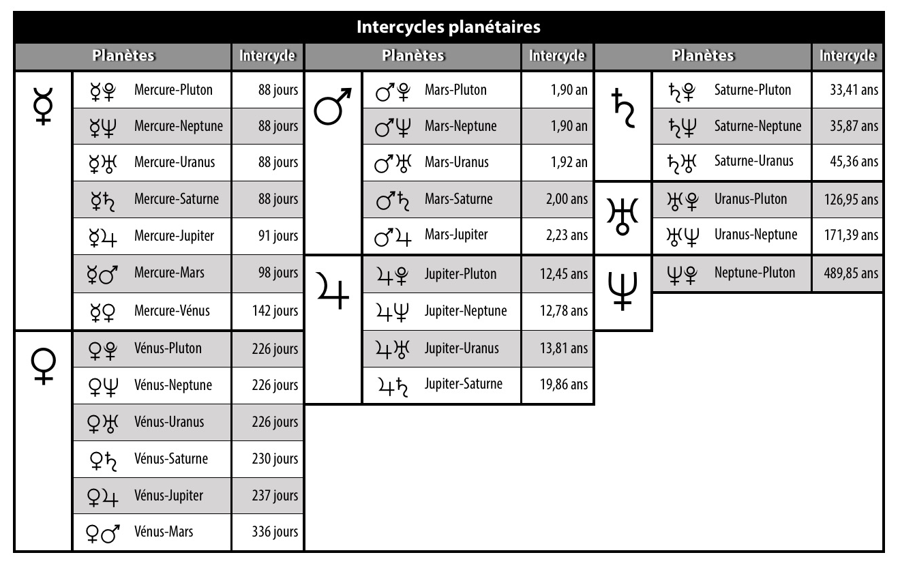
The nature of the planets in aspect takes precedence over the quality (consonant, dissonant or neutral) of the aspect.
Let us take the example of an aspect between Sun (“rR non-T” in the R.E.T.) and Pluto (“tT non-R”): it connects the hyper-simple and the hyper-complex, the sayable and the unspeakable, the maximum involvement and the optimal distance, the appearance and the being, the conscious and the unconscious, etc. These two planetary functions are naturally antagonistic, as day is opposed to night. Whether the aspect which connects them is consonant, neutral or dissonant, this antagonism of constitution will be maintained. A sextile, a trine or a conjunction receiving consonant aspects will certainly allow these two planets to establish a more relaxed dialectical relationship, of the style “peaceful coexistence” respecting differences: it will not, however, abolish these absolute differences. A square, an opposition or a dissonant conjunction, on the other hand, will radically aggravate these basic antagonisms.
Let us now take the example of an aspect between Mars (‘eE’ in the R.E.T.) and Venus (‘eR’). These two planetary functions have the same purpose (‘e’): to experience, to feel, to intensify the experience. They are naturally consistent. Whether the aspect that unites them is consonant, neutral or dissonant, it will always be a question of existing stronger, of reacting affectively, of focusing on sensations. A sextile or a trine will further reinforce, if need be, the concordant nature of these two planets. A square or an opposition, while dialectizing their relationship, will induce tensions in the psychic universe that are infinitely less than a dissonance between Sun and Pluto. We can draw up a list of naturally concordant or antagonistic planets.
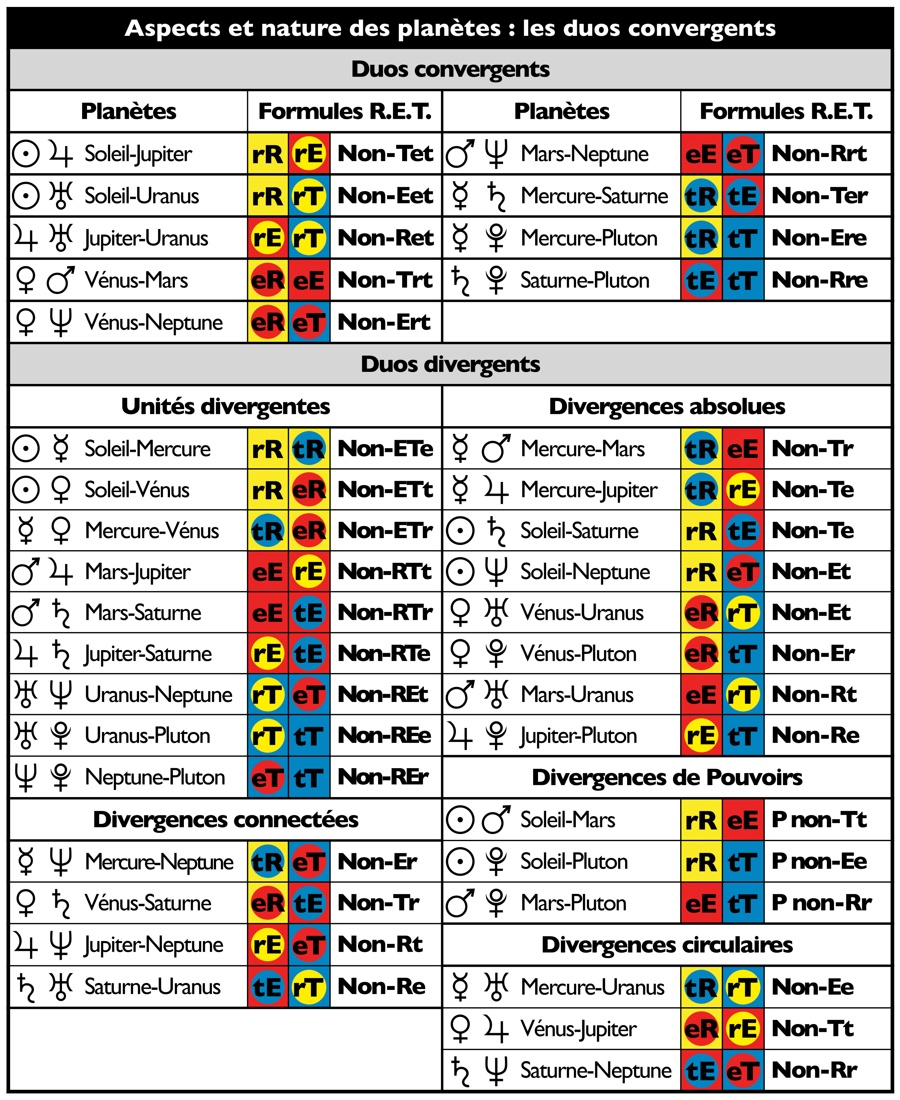 The Concordants
The Concordants
▶ the planets belonging to the same intensive group: Sun, Jupiter and Uranus (‘r’ family); Venus, Mars and Neptune (family ‘e’); Mercury, Saturn and Pluto (‘t’ family). Their purpose being identical, the relaxation caused by the consonant aspects is reinforced, while the tensions implied by the dissonances are reduced. The planetary couples nevertheless introduce different nuances within the group of concordants.
The antagonists
These are the planets whose functions are inverse (e.g. Sun-Pluto or Mercury-Uranus) or those which have nothing in common. Between these antagonistic planets, the relaxation brought by the consonant aspects is more akin to a “peaceful coexistence” or to a “marriage of convenience” than crazy love… The tensions induced by the dissonances are, on the other hand, extreme.
The ambivalent
▶ the planets belonging to the same extensive group: Sun, Venus and Mercury (family ‘R’); Jupiter, Mars and Saturn (‘E’ family); Uranus, Neptune and Pluto (‘T’ family). Their starting point is the same, but their goals are different. The relaxation caused by the consonant aspects is reinforced, but on the other hand the dissonances dramatize the differences in purpose: the tensions and conflicts thus created can be extremely sharp.
- the extensive group Sun, Mars and Pluto (‘P’ family): the common point of these planets is that they do not have any… except that of remaining at their level (‘rR’, ‘eE’, ‘tT’). We are here in the presence of an ambivalent antagonism: we do not understand each other but we respect each other. The relaxation caused by the consonant aspects is quite relative: we cooperate, of course, but by spying on each other. Vigilance remains in order. We cannot completely let go. The tensions induced by the dissonant aspects powerfully highlight the antagonisms. The dialectics are radical and the subordinations difficult to find.
- the intensive group that the Moon forms on its own (family ‘p’). The lunar function, as we have noted, is a function of globality, of homogeneity, of “virtual world”. The relaxation caused by the consonant aspects of the Moon allows this undifferentiated globality, pregnant with potentialities, to specialize “slowly” by allying with a planetary function. The overall perception-reception that we have of the world is harmoniously “oriented” and structured by the planet in aspect to the Moon. The tensions induced by the dissonant aspects are, on the other hand, extreme: the planet in square or opposition to the Moon functions in “break in homogeneity”. In the lunar world of non-choice, it obliges to choose, and painfully. The tensions are likely to explode the “lunar bubble”… In this sense, the lunar function is antagonistic to all the other planets.
▶ Aspects theory and practice
▶ Les aspects, phases d’un cycle
▶ Aspects : existe-t-il un modèle traditionnel ?
▶ Aspects : théorie et bilan conditionaliste
▶ Introduction à l’interprétation des aspects
▶ The planetary Aspects and their orbs
▶ Les Aspects kepleriens
▶ Les “aspects” aux Angles
▶ Chronologie des Aspects et Transits
▶ A brief history of interplanetary aspects
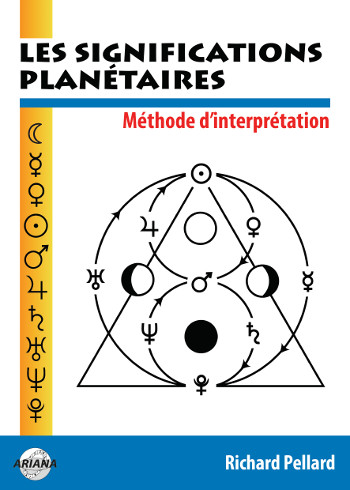
Les significations planétaires
par
620 pages. Illustrations en couleur.
La décision de ne traiter dans ce livre que des significations planétaires ne repose pas sur une sous-estimation du rôle des Signes du zodiaque et des Maisons. Le traditionnel trio Planètes-Zodiaque-Maisons est en effet l’expression d’une structure qui classe ces trois plans selon leur ordre de préséance et dans ce triptyque hiérarchisé, les Planètes occupent le premier rang.
La première partie de ce livre rassemble donc, sous une forme abondamment illustrée de schémas pédagogiques et tableaux explicatifs, une édition originale revue, augmentée et actualisée des textes consacrés aux significations planétaires telles qu’elles ont été définies par l’astrologie conditionaliste et une présentation détaillée des méthodes de hiérarchisation planétaire et d’interprétation accompagnées de nombreux exemples concrets illustrés par des Thèmes de célébrités.
La deuxième partie est consacrée, d’une part à une présentation critique des fondements traditionnels des significations planétaires, d’autre part à une présentation des rapports entre signaux et symboles, astrologie et psychologie. Enfin, la troisième partie présente brièvement les racines astrométriques des significations planétaires… et propose une voie de sortie de l’astrologie pour accéder à une plus vaste dimension noologique et spirituelle qui la prolonge et la contient.
Téléchargez-le dès maintenant dans notre boutique
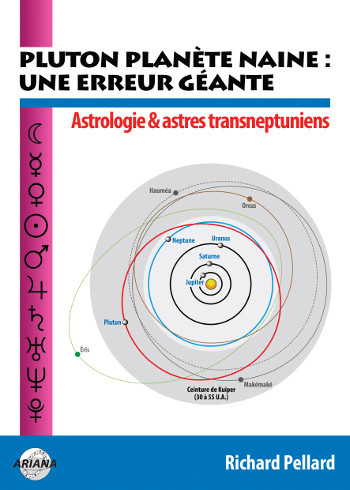
Pluton planète naine : une erreur géante
par
117 pages. Illustrations en couleur.
Pluton ne fait plus partie des planètes majeures de notre système solaire : telle est la décision prise par une infime minorité d’astronomes lors de l’Assemblée Générale de l’Union Astronomique Internationale qui s’est tenue à Prague en août 2006. Elle est reléguée au rang de “planète naine”, au même titre que les nombreux astres découverts au-delà de son orbite.
Ce livre récapitule et analyse en détail le pourquoi et le comment de cette incroyable et irrationnelle décision contestée par de très nombreux astronomes de premier plan. Quelles sont les effets de cette “nanification” de Pluton sur son statut astrologique ? Faut-il remettre en question son influence et ses significations astro-psychologiques qui semblaient avérées depuis sa découverte en 1930 ? Les “plutoniens” ont-ils cessé d’exister depuis cette décision charlatanesque ? Ce livre pose également le problème des astres transplutoniens nouvellement découverts. Quel statut astrologique et quelles influences et significations précises leur accorder ?
Enfin, cet ouvrage propose une vision unitaire du système solaire qui démontre, chiffes et arguments rationnels à l’appui, que Pluton en est toujours un élément essentiel, ce qui est loin d’être le cas pour les autres astres au-delà de son orbite. Après avoir lu ce livre, vous saurez quoi répondre à ceux qui pensent avoir trouvé, avec l’exclusion de Pluton du cortège planétaire traditionnel, un nouvel argument contre l’astrologie !
Téléchargez-le dès maintenant dans notre boutique